A shoot-out featuring thousands of lasers is about to break out in low earth orbit. Luckily, no one will get hurt—the lasers’ targets are the protagonists’ own communications satellites.
Amazon has just announced that two of its prototype internet satellites equipped with infrared lasers transferred data at 100 gigabits per second over a distance of nearly 1000 kilometers. The company says all of its upcoming 3236 Project Kuiper satellites will include such interlinks, forming a high-speed mesh network to route data around the world.
SpaceX’s rival Starlink system, which already boasts over 1.5 million customers including the Ukrainian military, has been experimenting with optical interlinks for about a year. It recently claimed to have more than 8,000 space lasers on its newest generation of satellites, which began launching earlier this year.
Now the race is on to build the first complete optical inter-satellite link (OISL) constellation, at a price that’s competitive with terrestrial 5G and fiber networks.
Lasers make sense
Lasers make a lot of sense in the vast emptiness space. Optical signals have a higher frequency, and thus a higher bandwidth, than radio waves. Lasers also focus signals into a much tighter beam, increasing security and reducing power requirements. The narrower beams mean less risk of optical signals from different constellations interfering with each other, and outside the radio realm there are no regulators telling operators which parts of the electromagnetic spectrum they can and can’t use.
A large fleet of OISL satellites in low earth orbit can bounce signals around the world, improving coverage in areas with few ground stations to connect to the terrestrial internet. And with light traveling 50 percent faster in a vacuum than through glass fiber, an orbiting mesh network could theoretically connect users in, say, London and New York, much quicker than undersea cables.
But there are problems, too. Aiming a laser beam across thousands of kilometers, between satellites moving at thousands of kilometers per hour in different directions, is no mean feat. And with clouds blurring or blocking signals, lasers aren’t ideal for communicating with systems on the ground. Laser terminals are also still much pricier than radio transceivers.
Making optical inter-satellite links work
As early as 2001, the European Space Agency established the first inter-satellite link, between low earth and geostationary orbits. Then in 2013, NASA beamed a picture of the Mona Lisa to the Lunar Reconnaissance Orbiter. In 2019, IEEE Spectrum broke the news that Facebook was experimenting with satellite lasers. Two years later, the team behind that prototype moved to Amazon to work on Kuiper.
Now OISL technologies are finally ready for business. In addition to Amazon and SpaceX, lasers will power communication constellations from veteran operator Telesat, China’s state-owned GuoWang, Canadian start-up Kepler, and others.
These constellations should allow users in remote regions to connect to the internet, shipping companies to track their vessels, and governments and militaries to have high-quality, secure communications. But what they won’t do right away is kickstart an orbital equivalent of the terrestrial internet.
“The current optical intersatellite links are like building infrastructure where you have nodes that can connect and can relay data across large distances,” explains Kerri Cahoy, MIT professor of aeronautics and astronautics. “What doesn’t exist yet is how everybody else plugs into that and uses it with their own application.”
Proprietary tech in Amazon’s and SpaceX’s constellations means satellites from other operators, such as earth imaging operators, cannot directly connect to the new optical mesh networks.
Standard deviation
The U.S. Space Development Agency (SDA) developed a standard for laser terminals, such as the lasers’ wavelengths and polarization, and these guidelines have been adopted by several players in the industry. However, an Amazon spokesperson confirmed to Spectrum that Kuiper will not use that standard.
“We designed the Kuiper network to provide broadband service to customers worldwide, which requires data throughput and latency requirements that are different than the maximum data rate supported by the SDA,” they wrote. SpaceX did not immediately respond to requests for comment.
Standards to ensure terminals are interoperable and can schedule, transfer, and route data to one another “are still evolving,” says Cahoy. “But it’s a fun future to imagine. Once there are on-orbit network connections, they will enable increased onboard processing, decision-making and autonomy about earth observation.”
She envisages a world where satellites could be dynamic and independent enough to track shipments or oversee mining operations. Ultimately, Cahoy says, the constellations could enable permanently-connected autonomous vehicles. “These types of networks could provide coordination and mapping and planning among the vehicles, as well as allowing productivity and entertainment for the occupants of them,” she says. “It’s kind of exciting.”
Project Kuiper intends to start a full-scale deployment in the first half of 2024, with enough satellites aloft to begin early customer pilots in the second half of the year.
- Amazon’s Project Kuiper is More Than the Company’s Response to SpaceX ›
- Amazon Reports Collision Risk for Mega-Constellation of Kuiper Internet Satellites ›
Mark Harris is an investigative science and technology reporter based in Seattle, with a particular interest in robotics, transportation, green technologies, and medical devices. He’s on Twitter at @meharris and email at mark(at)meharris(dot)com. Email or DM for Signal number for sensitive/encrypted messaging.



